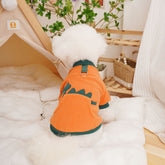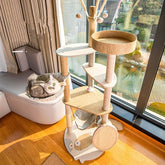Gentle Ways to Soothe Your Cat During Stressful Times
Table of Contents
- Key Highlights:
- Introduction
- Understanding a Cat’s Body Language
- Using a Calm and Gentle Voice
- Offering Safe Hiding Spots
- Controlling the Environment
- Playing Soft Music or Cat-Specific Sounds
- Using Feline Pheromone Diffusers
- Providing Visual Barriers
- Maintaining a Consistent Routine
- Offering Interactive Toys
- Using Treats as Comfort
- Giving Them Space and Time
- Watching for Triggers
- Practicing Slow, Predictable Movements
- Talking to Your Cat from a Distance
- Letting Natural Light In
- Using Scents Cats Love
- Encouraging Window Watching
- Providing Vertical Space
- Leaving Familiar Objects Nearby
- Using Gentle, Repetitive Sounds
- Observing and Respecting Individual Personality
Key Highlights:
- Understanding a cat's body language is crucial for assessing their comfort level and responding effectively.
- Creating a calming environment through sounds, scents, and visual barriers can significantly help alleviate feline anxiety.
- Providing your cat with safe spaces, consistent routines, and gentle interactions fosters a sense of security that can reduce stress.
Introduction
Cats are enigmatic creatures whose complex emotions often leave their owners puzzled, especially when faced with stress or anxiety. Whether it's the sudden onset of fireworks, an unexpected visitor, or the mundane vacuum cleaner, a seemingly innocuous event can trigger a cat's instinct to retreat, seek shelter, or exhibit signs of distress. Understanding the nuances of cat behavior and offering comfort without physical contact is paramount for any cat owner wanting to foster a sense of security and well-being for their feline companion. This guide delves into effective, gentle, and non-intrusive strategies to soothe your cat throughout stressful episodes, offering insights into their world, body language, and sensory experiences.
Understanding a Cat’s Body Language
Understanding a cat's body language is the first step toward providing reassurance. Cats communicate through various signals — their tail position, ear orientation, and even pupil size can give crucial insights into their emotional state. For instance, a puffed-up tail and flattened ears are often signs of fear or aggression, while relaxed ears and a softly flicking tail can indicate curiosity or contentment.
Observing a cat's behavior can guide your approach; if they choose to hide or maintain a low stance, they’re likely signaling a need for space. This silent communication is akin to a friend needing personal time after a rough day. The most effective way to comfort a cat is to respect these signals, allowing them to express their feelings without intrusion.
Using a Calm and Gentle Voice
The tone of your voice carries significant weight in how your cat interprets comfort. A calm, soothing voice can help in alleviating anxiety. Avoid sudden outbursts or high-pitched tones that may startle your feline friend. Instead, consider humming or speaking softly; even if your cat appears indifferent, the consistency of your gentle tone can help them associate your presence with safety.
Cats have a keen sense of hearing, much more sensitive than that of humans. This means that your whisper may carry more impact than you realize. Sometimes, merely being a quiet presence can be enough to help your cat feel less isolated.
Offering Safe Hiding Spots
Cats instinctively look for safe spaces when they’re feeling threatened. By providing cozy hiding spots, such as a soft cat bed or a cardboard box lined with a blanket, you offer them refuge. Position these hideaways in quiet areas of your home, away from the clamor of daily activities. Understanding and facilitating their need for privacy can help reduce anxiety significantly.
When a cat has access to a secure place, they can retreat whenever they feel overwhelmed. It’s crucial, however, to avoid forcing them out of these spaces; let them emerge when they feel comfortable.
Controlling the Environment
The environment plays a critical role in a cat’s stress levels. Adjusting the surroundings can create a tranquil atmosphere conducive to relaxation. This could mean dimming the lights, reducing loud noises, or closing windows during storms and fireworks.
Encouraging family members to speak softly and move quietly also contributes to a comforting space. Maintaining a routine is equally important, as unexpected changes can heighten anxiety in cats. A peaceful environment acts as a sanctuary for their recovery.
Playing Soft Music or Cat-Specific Sounds
Music can tremendously affect a cat’s mood. Playing soft classical melodies or specially designed cat-friendly soundtracks can help reduce stress. There are curated playlists available online, featuring gentle compositions and nature sounds. Keeping the volume low allows your cat to enjoy the soothing atmosphere without feeling overwhelmed.
By associating these calming sounds with positive experiences, such as during meal times or cuddles, your cat may eventually seek out these auditory cues as sources of comfort.
Using Feline Pheromone Diffusers
Feline pheromone diffusers, which mimic the calming signals emitted by mother cats to their kittens, can be transformative for anxious cats. These diffusers are scentless to humans, yet cats respond favorably, often exhibiting more relaxed behavior.
By placing a diffuser in the primary area where your cat spends the most time, you can help alleviate stress over days. This method is particularly beneficial during transitions, such as moving to a new house or introducing new pets into the home.
Providing Visual Barriers
To create a calming environment, consider blocking out excessive visual stimuli. Using curtains, room dividers, or other physical barriers can help your cat feel secure when discomfort arises from guests or other pets.
By minimizing stimuli, you allow your cat to take control of their environment, similar to how a child would shield themselves with a blanket during scary moments. This freedom can be instrumental in reducing anxiety.
Maintaining a Consistent Routine
Cats thrive on routine. Predictability can be incredibly comforting, so keeping their meal and playtimes consistent can instill a sense of security. Minor disruptions to their schedule may cause stress, so maintaining a predictable environment can be calming.
Additionally, little rituals, like a gentle greeting in the morning, can reinforce stability in their daily lives. Routine is key in reminding our cats that despite external challenges, their essential needs remain constant.
Offering Interactive Toys
Even during anxious times, providing interactive toys can offer a gentle distraction. Toys such as wand sticks or puzzle feeders engage your cat without necessitating physical contact. They can redirect nervous energy toward play, reinforcing positive behaviors rather than stressing over triggers.
Choosing toys that mimic natural prey can also tap into your cat’s instincts, offering a constructive outlet for their feelings. Allow your cat to dictate the pace of play; often, watching a toy can spark curiosity and distract them from anxiety.
Using Treats as Comfort
Strategically using treats can also alleviate a cat's stress. Tossing their favorite snack nearby allows them to approach at their own pace, fostering positive associations. Certain calming treats containing ingredients such as chamomile or L-theanine can also assist in curbing anxiety.
It’s crucial, however, to use treats carefully, ensuring they remain a reward rather than a crutch. By creating comfort associations with these rewards, you foster an environment of safety and ease.
Giving Them Space and Time
Sometimes, an essential aspect of soothing an anxious cat is to give them the space they require. Avoid hovering or staring; your cat is likely to sense your anxiety and feel compelled to retreat further. Trusting them to emerge on their terms can strengthen the bond you share, as it shows understanding and patience.
Permitting a cat the freedom to recuperate in their own time is valuable in respecting their individuality and unique emotional landscape.
Watching for Triggers
The first step in minimizing anxiety is identifying triggers. Whether it’s the sound of a doorbell, a vacuum, or specific visitors, awareness of these stressors can significantly help in preventing stressful situations. Developing strategies to manage these triggers ensures a more peaceful environment, like relocating your cat to a quieter area during high-stress events.
Keeping a mental diary of stress triggers may prove beneficial, allowing for pattern recognition and proactive management of your cat’s anxiety.
Practicing Slow, Predictable Movements
Cats are naturally apprehensive of sudden movements. Therefore, adopting a slow, deliberate manner around anxious cats can be reassuring. Avoid abrupt gestures or reaching toward them too quickly, as this can escalate their anxiety.
Moving calmly around your cat illustrates that you present no threat. Consistently practicing this approach will create a reassuring presence that fosters their comfort over time.
Talking to Your Cat from a Distance
Even if your cat is retreating, communicating from across the room can help remind them that they are not alone. Using familiar words or phrases in a gentle tone can offer them validation and reassurance. Many cats may even peek out to acknowledge you, appreciating your presence and the bond you share despite the physical distance.
This tactic preserves their space while demonstrating your affection and concern, contributing to a nurturing atmosphere.
Letting Natural Light In
Natural light can have a wonderfully calming effect on cats. Allowing sunlight to flood their favorite resting spot is an easy way to foster comfort. Cats love basking in warm beams as they provide not only heat but also a sense of relaxation.
Designating a cozy area near a window gives your cat the opportunity to soak in the sun while creating a serene ambiance. The therapeutic benefits of sunlight can brighten their mood and help alleviate feelings of anxiety.
Using Scents Cats Love
Familiar scents can provide significant comfort. Placing cat-safe fragrances like silver vine or valerian in their environment can contribute to a calming atmosphere. Alternatively, letting your cat sit with a worn piece of your clothing can help them feel more connected and secure.
Avoid synthetic fragrances, which may backfire; stick to natural scents that cats find soothing, and introduce any new smells gradually to avoid startling them.
Encouraging Window Watching
Cats love observing the outside world. Setting up a cozy perch near a window allows them to observe birds, squirrels, and other sights, providing both entertainment and comfort. Observational activities serve as a distraction from potential stressors, engaging their curiosity and giving them agency over their environment.
Creating a stimulating, interactive view outside can augment their enjoyment and diminish their focus on anxiety-inducing scenarios within the home.
Providing Vertical Space
Cats feel more secure when they can survey their domain from a height. Providing vertical space through climbing shelves or cat trees not only gives them a sense of safety but also freedom to explore. High vantage points create havens for them during stressful episodes, allowing them to assess their surroundings without fear.
A designated high space acts as a hideout, giving your cat a place to recharge during turbulent times.
Leaving Familiar Objects Nearby
Familiar items such as toys, blankets, or beds can bolster comfort for anxious cats. These possessions carry scents and memories that serve as reminders of safety and joy. Rotating these objects helps maintain interest and accessibility to comfort items.
When they feel overwhelmed, having ready access to something they recognize can provide a crucial layer of reassurance, akin to a cherished childhood toy.
Using Gentle, Repetitive Sounds
Rhythmic, soft sounds can soothe an anxious cat. Background noise, such as the hum of a fan or ambient white noise, can mask unexpected sounds that might trigger stress. By finding the right calming background sound, you create a consistent atmosphere of peace.
Experimenting with various sounds can help you determine what resonates best with your cat. Establishing these soothing auditory cues can develop into a beloved source of comfort over time.
Observing and Respecting Individual Personality
Every cat possesses a unique personality and temperament. Some may be outgoing, while others are more reserved. Recognizing and respecting these differences is vital for developing a supportive relationship. What soothes one cat may intensify anxiety in another.
Tailor your approach according to your cat’s individual needs and proactively adapt as you learn more about what brings them comfort. Patience and understanding can enhance your bond, fostering an environment of trust and security.
FAQ
How can I tell if my cat is stressed?
Signs of stress can include hiding, excessive grooming, aggressive behaviors, and changes in eating or litter box habits. Observing your cat's body language is crucial; a puffed tail or flattened ears can indicate fear or anxiety.
What should I do if my cat hides during a storm?
Allow your cat to remain in their hideout while creating a calm environment around them. Dimming lights, reducing noise, and playing soft music can help alleviate their anxiety.
Are there specific sounds that comfort cats?
Many cats find soft classical music or gentle nature sounds comforting. You can also explore tracks designed specifically for cats to promote relaxation.
Can I train my cat to be less anxious?
While you can't directly "train" away anxiety, you can help them by creating a nurturing environment, establishing routines, and consistently observing their preferences for comfort.
Is it safe to use calming treats for my cat?
Most calming treats made with natural ingredients are safe, but consult your veterinarian before introducing new snacks, especially if your cat has dietary restrictions or health concerns.
Creating a serene and comforting environment for your cat requires patience, observation, and care. Employing these strategies can help ease their worries and strengthen your bond, allowing them to flourish in a space that feels safe and loved.





